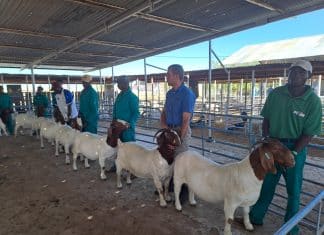Estimated reading time: 7 minutes
Attention to key management aspects such as compaction, cutting at the most optimal time and feed-out with minimal wastage and exposure to oxygen – these aspects are non-negotiable for producers who want to make top-quality silage.
Silage production can be a lifeline during a drought
Combined with the application of information gathered through courses and discussions with other producers in a study group, these aspects resulted in Ian Gerber of the Gerber Boerdery Trust near Hoekwil in the Southern Cape, earning a well-deserved third place in the maize silage category of Plaas Media’s 2021 Santam Agriculture National Silage Competition.
This was the first time he competed in this popular competition, says Ian. Laetitia Walters, a nutritionist from AFGRI Animal Feeds in George, suggested that he enter his maize silage. “She suggested we participate, as the laboratory analyses results would show us how our quality compares to that of other producers.
“Given that it was our first time competing and being named one of ten finalists out of 72 maize silage entries, and then fetching third place, came as quite the surprise. I am confident it’s because of the attention we pay to especially compaction and optimal cutting stage. Even the students that came to collect the samples asked how we managed to compact the silage so firmly, as they really struggled to drill into it to collect the samples.”

Cut at the right time
To make top-quality hay, it is essential to cut the crop at the right time as it has a huge influence on the quality of the silage produced. Ian cuts when the dry-matter content of the maize is 35%, which is also when the starch content is at its highest.
“We used to cut earlier, but nowadays we take a few samples beforehand that we dry in the microwave to determine the correct dry-matter content.”
His decision to follow this course of action came about because of the information imparted by the producers in a study group, which includes the Outeniqua research farm at George. One of the participants is Prof Robin Meeske, head of the research farm and patron of the silage competition’s protocol. He gives the producers access to the farm’s research information.
Prof Meeske’s participation in the study group also led to Ian’s decision to construct a cement wall bunker. Where he had previously made silage in piles, he now has a more scientific approach to the silage-making process. He plants Bayer’s DEKALB maize hybrid DKC64-54BR. “It is not a silage cultivar as such, but a grain cultivar. However, it provides for more grain in the silage, which in turn provides for more energy.”
The maize is grown under irrigation to counteract the negative effects of drought. To ensure that he produces the best maize for his silage, Ian keeps a close eye on his cultivation practices – fertiliser is applied according to soil analyses and spraying is done at critical times.
The silage tested in the competition was fertilised at a rate of 10m3 cattle manure per hectare prior to planting. This year, his fertiliser consisted of 10m3 of chicken manure per hectare.
Compaction and sealing
Once the maize has been cut at the right time, compaction is the next critical step in his ensiling process, says Ian. He is confident that thorough compaction is one of the secrets of his silage-making success. For the best compaction, there is one tractor compacting the maize for each tractor transporting the maize. “So, when four tractors are transporting, another four are compacting.”
After that, the sealing process completes the excellent work done – the silage must be sealed within 24 hours. Instead of placing tyres in rows, tyres are packed very tightly across the entire surface area. Water-filled 20ℓ plastic drums are placed against the walls of the bunker to ensure that the silage is airtight.
Equally important to the making of top-quality silage is managing the face of the bunker at feed-out. “To limit losses, you must only loosen and remove as much as you can use at that point in time. That is why we do not use a backhoe that loosens only the silage at the bottom so that much of the feed spills on the ground. We use everything that has been loosened. In the event that we receive ample rain and the cows can graze pastures only, the face is thoroughly sealed to limit losses.”
Ian says the farm has its own machinery and equipment, so the need for contractors is eliminated. This means they can start cutting as soon as the correct dry-matter content is reached – this also eliminates a lot of the risk. For example, cutting too early or too late affects the quality of the silage.

A balanced mixture
Since they strive for a very high solid content level in the cows’ milk, getting their nutrition 100% correct is essential. The quality of their silage needs to be optimal for the production of the best quality milk. This requires the right feed mixture with the right balance of protein and energy. The maize silage provides the mixture’s energy. For the protein component, Pannar’s Majoris oat cultivar is used for silage production.
For this too, the crop must be cut at the right time to ensure optimum quality. Where he previously cut the small grains during the soft-dough stage, he now cuts the oats much earlier – during the flowering stage – as recommended by a nutritionist. The protein content is higher, which improves the quality of the silage and the feed mixture.
Ian applies a concentrated probiotic silage inoculant, BioPro Silage, to the silage. It is a liquid concentrate containing probiotic micro-organisms that improve fermentation and aerobic stability.
For him, says Ian, the success of producing top-quality silage lies in a fine balance between numerous factors, such as the starch content, energy, the right cutting time for optimal dry-matter content, good compaction and keeping the silage thoroughly sealed, as well as the correct feed-out practices.
Abreast of developments
A big part of the success of his silage production is the courses he regularly attends – among others those presented by Richardt Venter, co-ordinator of the Santam Agriculture National Silage Competition. He also benefits greatly from the study group of producers of which Prof Meeske is a member. This helps him to stay abreast of the latest developments in silage production.
Ian says he took part in the competition to compare his silage with that of the winners, and intends to put the results of the laboratory tests to good use to improve his practices. – Chris Jooste, Stockfarm
Read more about trends in the 2021 silage competition.
For more information, contact Ian Gerber
on 084 576 6663 or ijgerber@hilbert.co.za.






